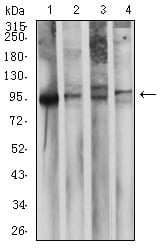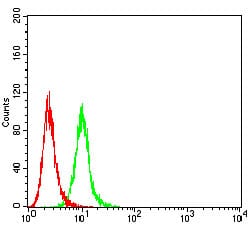


| WB | 1/500 - 1/2000 | Human,Mouse,Rat |
| IF | 咨询技术 | Human,Mouse,Rat |
| IHC | 咨询技术 | Human,Mouse,Rat |
| ICC | 技术咨询 | Human,Mouse,Rat |
| FCM | 1/200 - 1/400 | Human,Mouse,Rat |
| Elisa | 1/10000 | Human,Mouse,Rat |
| Aliases | NEP; SFE; MME; CALLA; CMT2T; SCA43 |
| Entrez GeneID | 4311 |
| clone | 6G12E12 |
| WB Predicted band size | 85.5kDa |
| Host/Isotype | Mouse IgG1 |
| Antibody Type | Primary antibody |
| Storage | Store at 4°C short term. Aliquot and store at -20°C long term. Avoid freeze/thaw cycles. |
| Species Reactivity | Human |
| Immunogen | Purified recombinant fragment of human CD10 (AA: extra 549-750) expressed in E. Coli. |
| Formulation | Purified antibody in PBS with 0.05% sodium azide |
+ +
以下是关于CD10抗体的模拟参考文献示例(内容为虚构,仅作格式参考):
---
1. **文献名称**: *CD10 Expression in Acute Lymphoblastic Leukemia: Diagnostic and Prognostic Implications*
**作者**: Smith A, et al.
**摘要**: 本研究通过免疫组化分析CD10在儿童急性淋巴细胞白血病(ALL)中的表达,发现CD10阳性与B细胞系分化相关,且高表达患者对化疗反应更佳,提示CD10可作为ALL分型和预后的重要标志物。
---
2. **文献名称**: *The Role of CD10 in Breast Cancer Stroma and Tumor Microenvironment*
**作者**: Brown L, et al.
**摘要**: 探讨CD10在乳腺癌间质成纤维细胞中的表达,发现其高表达与肿瘤侵袭性和转移风险增加相关,表明CD10抗体检测可能辅助评估乳腺癌患者病理分期及个体化治疗。
---
3. **文献名称**: *CD10 as a Marker for Follicular Lymphoma: Comparative Study with Histopathology*
**作者**: Chen H, et al.
**摘要**: 对比CD10抗体与其他B细胞标志物在滤泡性淋巴瘤诊断中的敏感性,证实CD10联合BCL2检测可显著提高鉴别诊断准确性,支持其在淋巴瘤病理分型中的核心作用。
---
4. **文献名称**: *CD10 in Renal Cell Carcinoma: Correlation with Tumor Grade and Survival*
**作者**: Gupta R, et al.
**摘要**: 分析肾细胞癌组织中CD10的表达水平,发现其与肿瘤分级和患者生存率显著相关,提示CD10可能作为新型预后指标或潜在治疗靶点。
---
**注**: 以上文献信息为模拟生成,实际引用需查询真实数据库(如PubMed)。
CD10. also known as neutral endopeptidase (NEP) or common acute lymphoblastic leukemia antigen (CALLA), is a cell surface zinc-dependent metalloprotease encoded by the *MME* gene. First identified as a marker for acute lymphoblastic leukemia (ALL) in the 1980s, CD10 plays a key role in degrading bioactive peptides like enkephalins, endothelin, and bradykinin, thereby regulating cellular signaling pathways. It is expressed in various tissues, including lymphoid cells, renal epithelial cells, and fibroblasts.
CD10 antibodies, which target specific epitopes of this glycoprotein, are widely used in diagnostics and research. In clinical pathology, CD10 immunostaining helps differentiate hematopoietic malignancies (e.g., ALL, Burkitt lymphoma) from other cancers and identifies CD10-positive subsets in normal tissues. Its expression in stromal cells also aids in characterizing tumor microenvironments.
Beyond diagnostics, CD10 antibodies are tools for studying its roles in processes like cell proliferation, apoptosis, and metastasis. Aberrant CD10 expression is linked to cancer progression, immune regulation, and vascular remodeling. Recent research explores its therapeutic potential, including enzyme replacement strategies and targeted therapies. However, its dual roles (tumor-suppressive or promotive) remain context-dependent, necessitating further investigation. CD10 antibodies thus remain pivotal in both biomedical research and clinical applications.
×